admin
Staff member
Next time you see some dinky little beginner’s bike, pit bike, pocket bike or el-cheapo Chinese knock-off that makes you chuckle thanks to it’s underwhelming features, poor build quality, or just plain lack of a single memorable trait to make it stand out from the crowd, take a moment to think about this: any and all modern bikes are amazing examples of technological development—no matter how cheap, throw-away or nasty they may appear to be, they stand proudly on the shoulders of almost 140 years of moto developments since the first bike was built in 1885.
The very fact that almost anyone with a modicum of riding experience can jump on 95% of the worlds motorcycles and use them in relative safety to get from point A to B should be a clear sign that the modern motorcycle is a humble technological marvel that takes some previously insurmountable engineering challenges and makes them look about as difficult as finding a Trump supporter at Sturgis. So here’s the top breakthroughs that transformed that arcane 1885 experiment into the modern motorbike we know, love, and ride today.
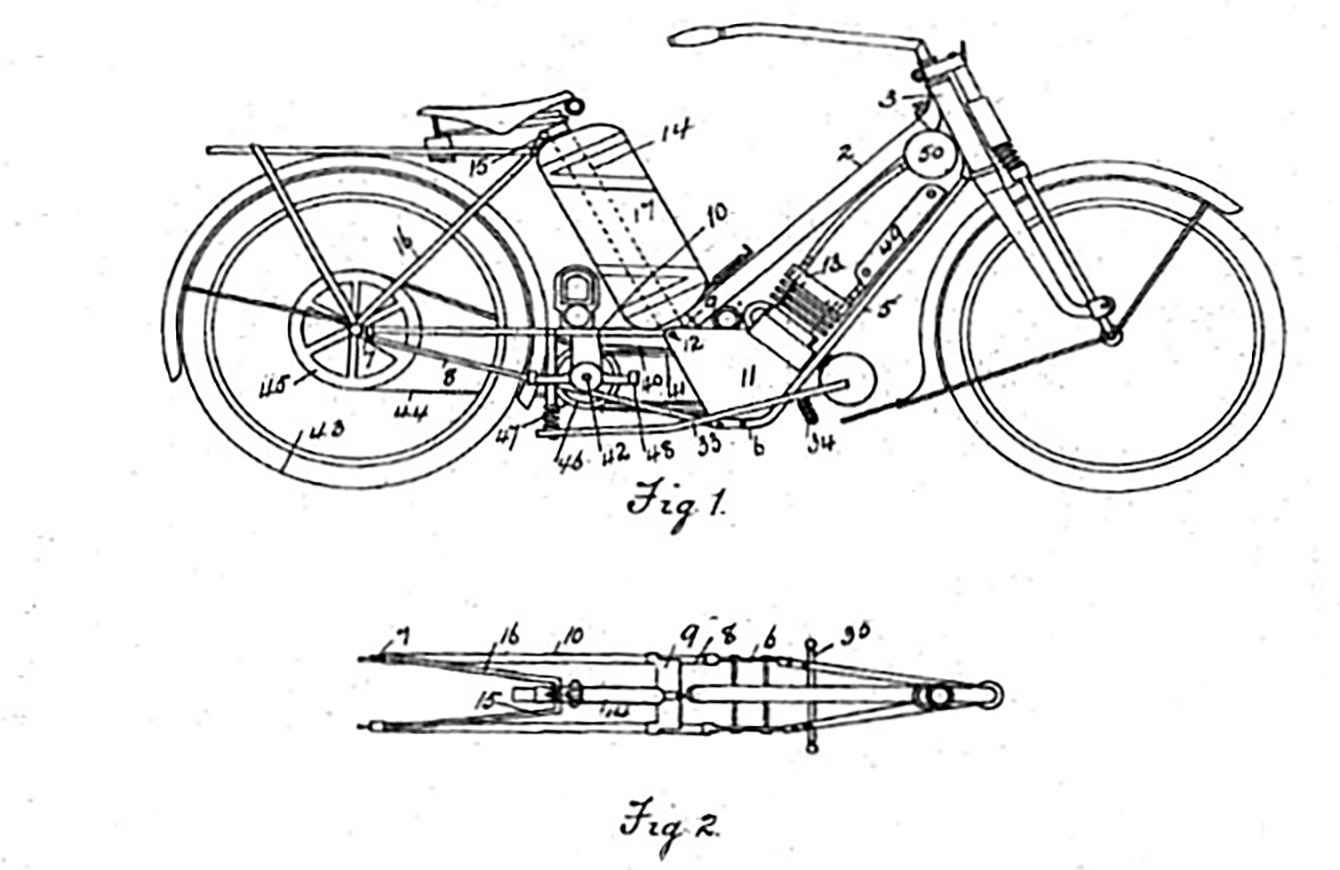
A 1908 Scott Patent Document. Image Via: Wikimedia Commons.
As anyone who’s ever attempted to ride a skateboard on an imperfect surface will know, suspension is a freaking wonderful thing to have. The first motorcycle fitted with some kind of dampening system to protect the rider and bike itself from feeling every little bump and hole in the road’s surface took more than two decades to surface, which is either a great testament to the power of pneumatic tyres or proof that most motorcyclists a just a little bit crazy upstairs. But it was indeed the 1908 Scott that is noted in the history books as the first commercially available motorcycle with front suspension.
Of course, motorcycles at this very early stage of development were nothing more than internal combustion-powered bicycles, and there’s plenty of bicycles around—even to this very day—they get along perfectly well without the need for suspension. But adding an engine to a bike means much more speed, and what may be a relatively mild or avoidable pothole when you are traveling at walking speed can take on a whole level of kidney-pummelling danger when you hit it at speed—or indeed when your forward velocity makes it nigh-on impossible to avoid without losing control.
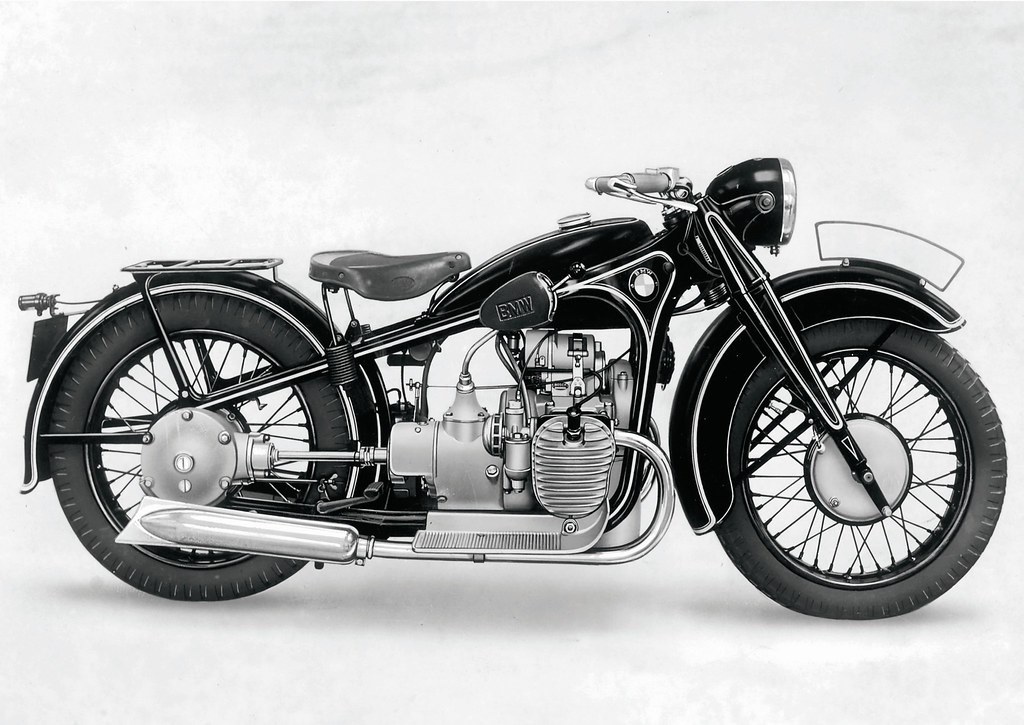
A 1935 BMW R12 with the first ever hydraulically damped telescopic front forks. Image Via: BMW Motorrad
And what a popular breakthrough it was; almost all motorcycles that took part in WWI had some form of front suspension, meaning that the technology went from rare to commonplace in as little as 6 years. And by 1935, BMW had developed a practical hydraulic damping system to make sure that those road bumps were dispensed of and not just transmitted back to the chassis and rider at a later date.
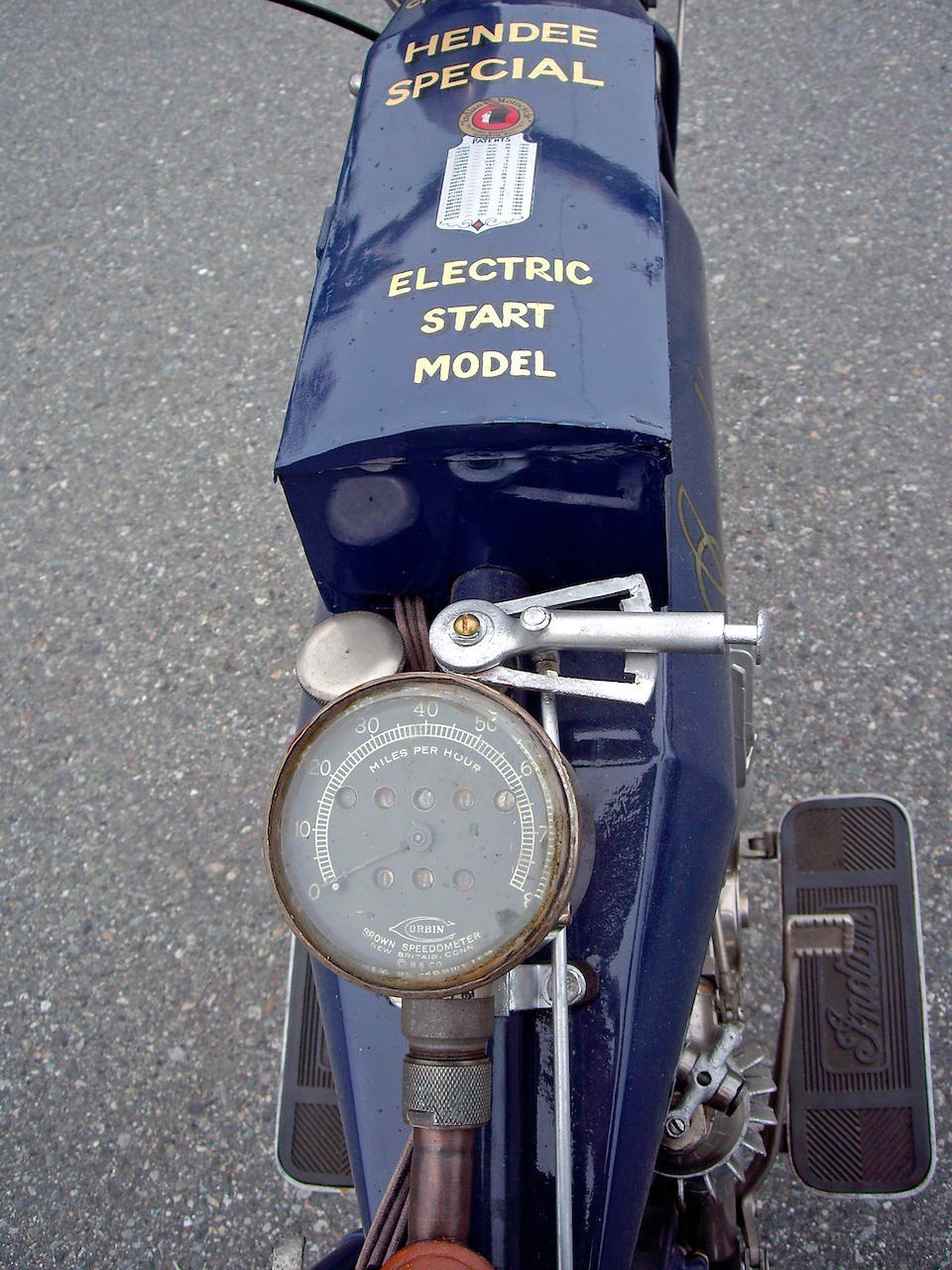
Just like it says on the box… Image Via: Bonhams.com
You haven’t lived ‘till you’ve almost killed yourself trying to start a kick-only motorcycle in the middle of nowhere while also noticing the approaching storm and the rapidly failing light. Ahhh, moto life’s simple pleasures!
But seriously, kickstarting motorcycles was an amazing deterrent to ensure many people who wanted to ride just plain didn’t. And while it undoubtedly has some very cool upsides for those that can manage to work them, it’s hard to defend them when it comes to practicality and user-friendliness.
Remarkably, the first motorcycle with an electric starter went on sale in 1914 (and only 4 years after the first kickstarted motorcycle from Scott), when the Hendee Motorcycle Company (who would go on to rebrand themselves as the Indian Motorcycle Company in 1926) installed a very early design onto one of their bikes.
Weirdly, though, the system never took off, and believe it or not, it took Honda’s revolutionary CB750 in 1969 before electric starters were small enough, refined enough, and effective enough to provide a real alternative to kickstarters.
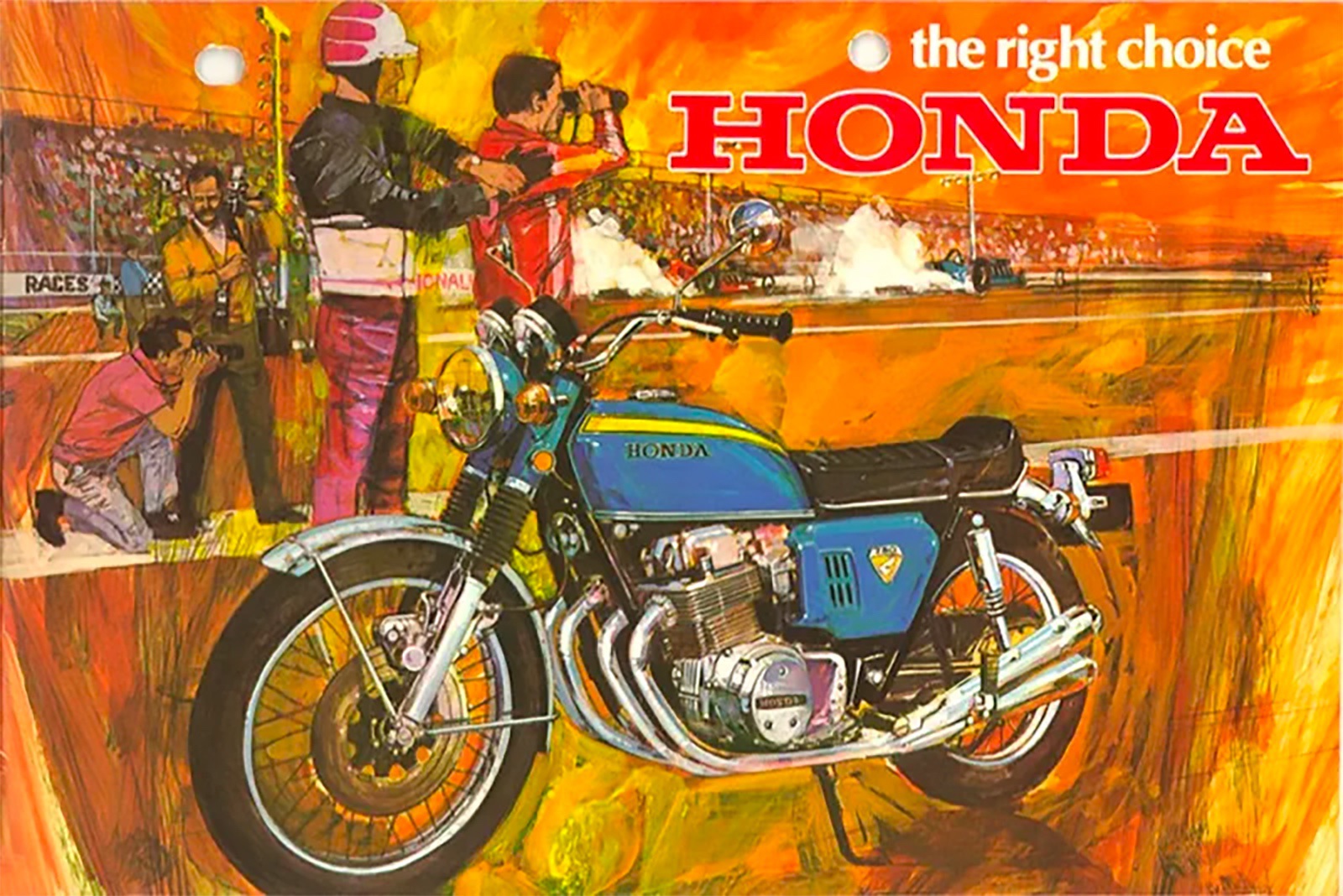
The good ol’ days when manufacturers had paintings on the front of their brochures. Image Via: Honda MC
Of course, when you think about the added weight an electric starter system adds, it does make sense that riders were willing to forgo it until something truly functional came along. And the fact that most bikes with an electric starter still needed to sport a “back-up” kickstarter as well meant many engineers and riders felt it just wasn’t worth the additional cost and weight. And speaking of Honda breakthroughs…
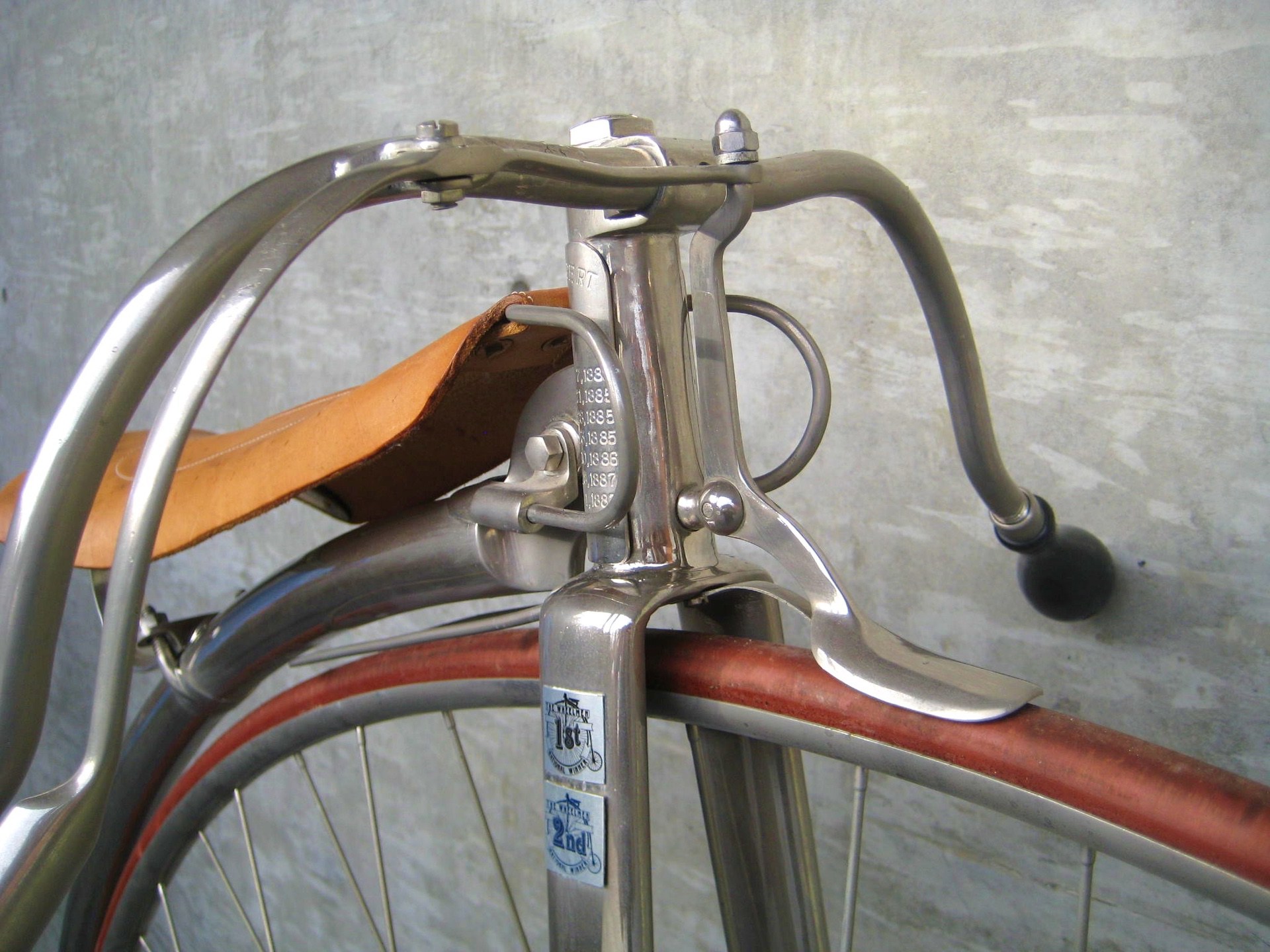
A spoon braking system on a penny farthing bicycle. Image Via: classiccycleus.com
If you still aren’t convinced that Honda and its CB750 pretty much invented modern motorcycling, along with electric starters, the Shizuoka behemoth also fitted a front disc brake to their breakthrough 1969 motorcycle. Unbelievably, early motorcycles had absolutely no brakes at all, apart from those things at the end of your legs your mother gave to you.
Then in 1902, Steffey Motorcycles of Philadelphia included a “spoon” brake (aka “a lever system that rubs on the bike’s tyres to slow them down”) to see if they could stop the mysterious habit their customers had made of crashing into things.
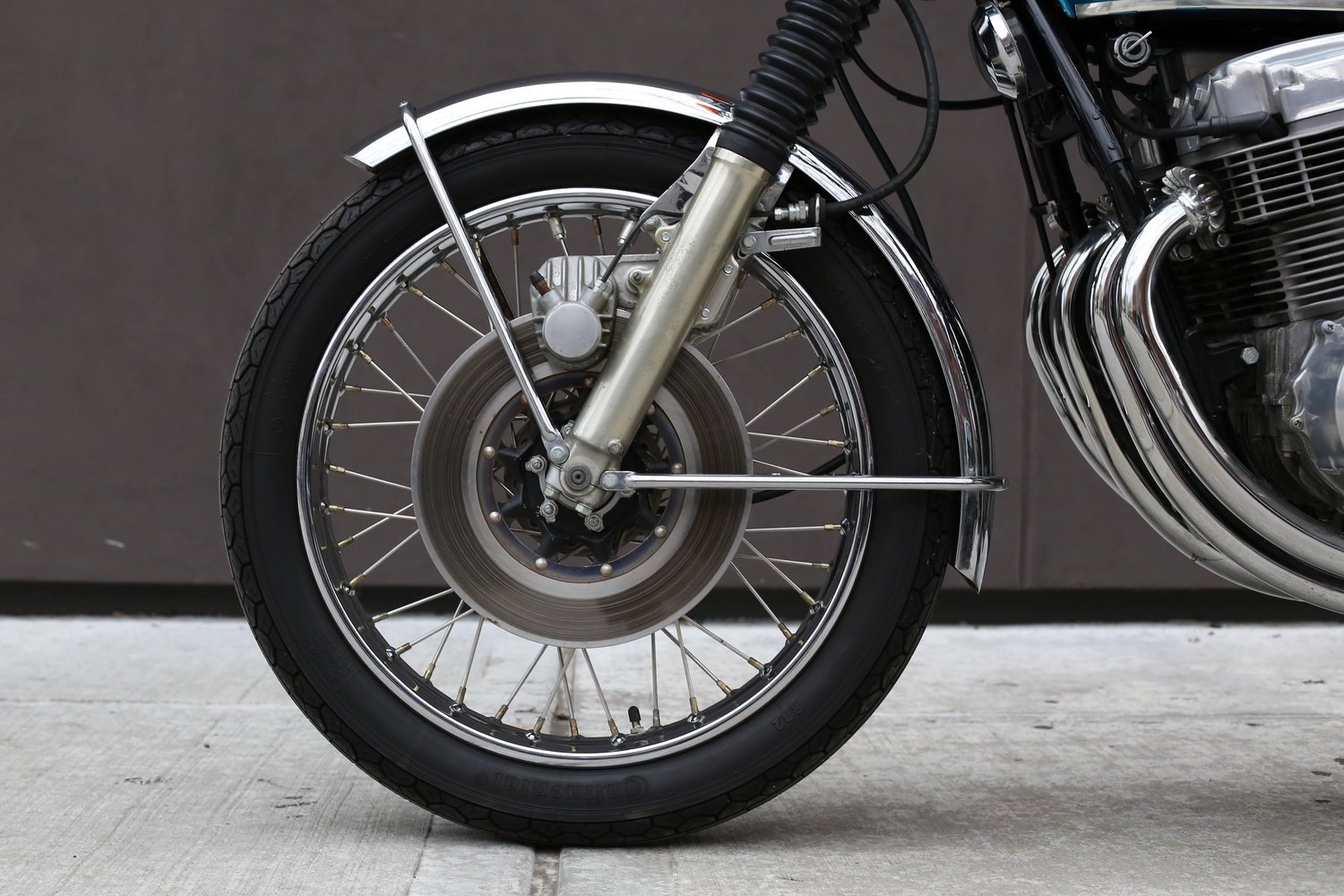
Honda’s first version of the CB750 disc brake system. Zero cooling holes. Image Via: motoborgotaro.com
Of course, drum brakes preceded Honda’s fancy new disc system, and even the most ardent disc brake fan would have to admit a properly adjusted drum brake is surprisingly effective. But the devil is in the “properly adjusted” part. See, drum brakes had a regrettable tendency to lose stopping power in the wet and they also have a pretty major dislike of getting hot, which for a brake system is like a boat being afraid of the ocean.
They also needed much more adjustment than this new disc system, and soon enough, they were resigned to the annals of moto history, too. Except if you were the owner of an 80s Jeep, but that’s a funny and non-moto story for another place and time.
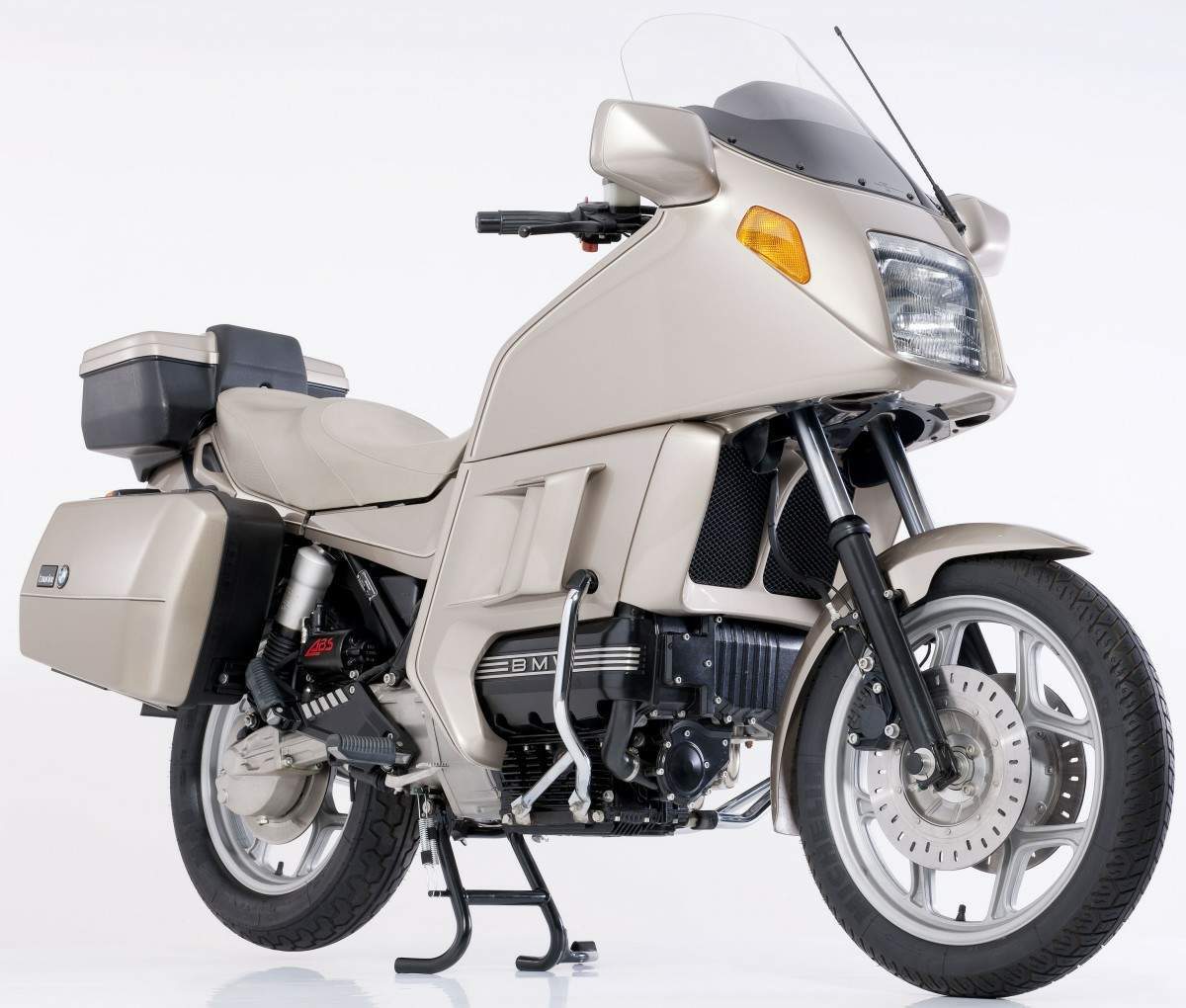
BMW’s “Flying Brick” K-Series bikes were the first motorcycles to be offered with an ABS option. Image Via: BMW Motorrad
What! More brakes? Anyone would think that braking on a motorcycle was important or something. Jokes aside, here’s a rather sobering point to consider; before ABS systems became more commonplace on motorbikes during the ’90s and ‘00s, a vast majority of riders on the world’s roads would have crashed their bikes rather than been able to bring them to a safe stop if they were forced to perform emergency braking at freeway speeds. Scary, huh?
The undeniable fact here is that when faced with a panic braking situation, riders would just grab a big fistful of lever and lock up the bike’s front tyre, giving them a sudden and very memorable date with Old Man Bitumen and his wife, Misses Gravel Rash. And while many riders might insist that they are skillful enough to be able to control themselves in such situations, the injury and death stats speak for themselves. ABS stops accidents and saves lives. End of story.
In a similar fashion to electric starters, ABS systems were available from the 80s onwards (Thanks again, BMW), but their size, expense and immaturity meant that the moto world just had to sit back and watch as manufacturers refined the systems and effectiveness of the results until ABS became a no-brainer. And then in 2016 or thereabouts (depending on what country you happen to ride in) most places made it mandatory for manufacturers to include ABS on all their bikes.
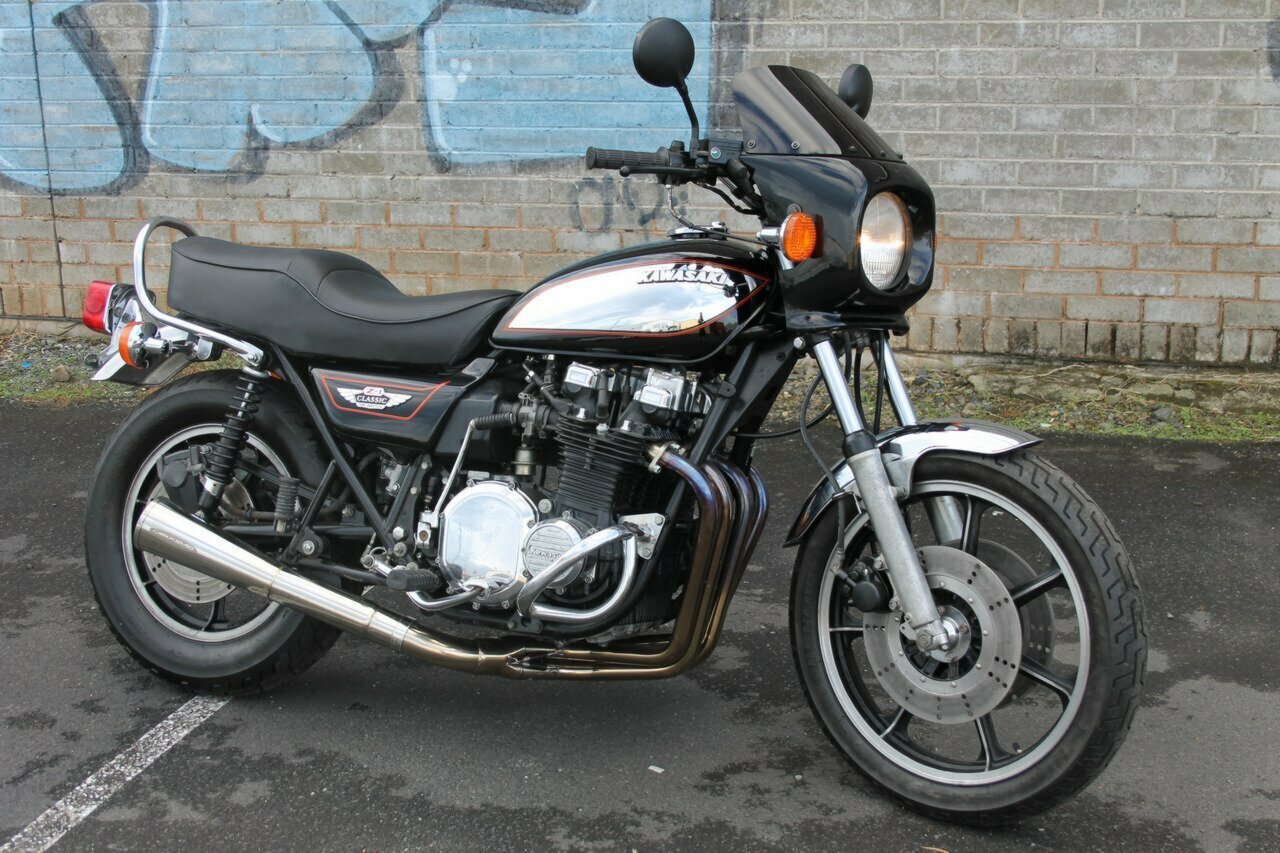
A Kawasaki KZ1000G in all its faux Harley glory. Image Via: justbikes.com.au
The latest of all these giant leaps was the gradual transition from carburetion to fuel injection. And while some of you may be quick to blame emissions controls for its popularity, that’s not strictly true. While carbs are the hand-down winners when it comes to simplicity and cost, fuel injection pretty much has it beat on all other counts, including fuel efficiency, power, performance, climatic adaptability and user-friendliness.
The 1980 KZ1000G from Kawasaki was the first mass produced, fuel-injected motorcycle (take that BMW) and within a decade the writing was on the wall for the poor old carbie—especially in the four-wheeled world.
By the end of the last decade, even very traditional makers like Royal Enfield were making the shift across to the decidedly not traditional fuel injection systems. And now exactly none of their new bikes are made without it.
For the younger riders amongst us, the fuss here may seem a little over baked, but for the oldies and those who’ve ever had the dubious distinction of owning a properly old motorcycle, the years it takes to get your head round the black magic goings-on required to make an old carbureted bike do what you want it to is beyond most of us in the time-poor modern riding world.
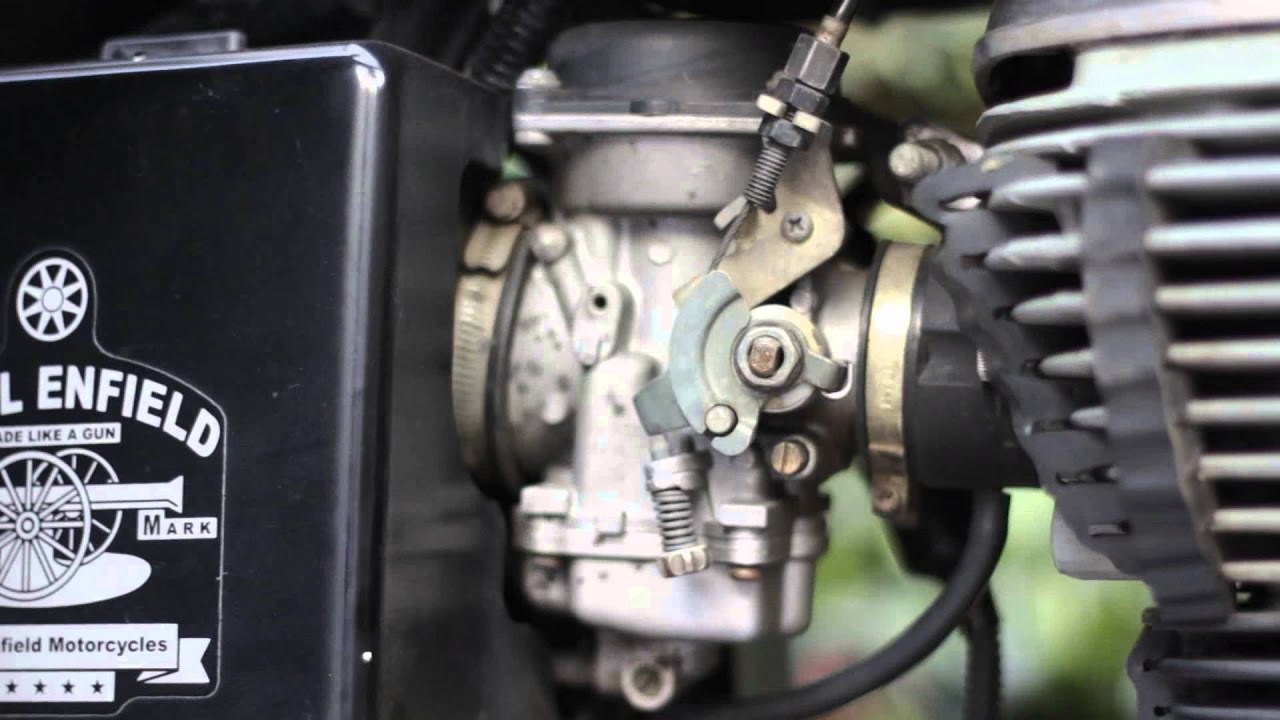
Downgrading Royal Enfields from fuel Injection to carbs is a popular pastime, but you can’t stop progress. Image Via: AutoCar India
Of course, we’re living through the next big breakthrough right now; that of the electrification of motorcycles. And while it may seem like a strange new world to those that know and love the art of internal combustion, you can bet that just like all the other innovations above, once it’s baked in and commonplace, most of us will be thinking the same thing. How did we ever do without it?
The post The Five Most Important Tech Breakthroughs In Moto History appeared first on webBikeWorld.
Continue reading...
The very fact that almost anyone with a modicum of riding experience can jump on 95% of the worlds motorcycles and use them in relative safety to get from point A to B should be a clear sign that the modern motorcycle is a humble technological marvel that takes some previously insurmountable engineering challenges and makes them look about as difficult as finding a Trump supporter at Sturgis. So here’s the top breakthroughs that transformed that arcane 1885 experiment into the modern motorbike we know, love, and ride today.
#1: Suspension

A 1908 Scott Patent Document. Image Via: Wikimedia Commons.
As anyone who’s ever attempted to ride a skateboard on an imperfect surface will know, suspension is a freaking wonderful thing to have. The first motorcycle fitted with some kind of dampening system to protect the rider and bike itself from feeling every little bump and hole in the road’s surface took more than two decades to surface, which is either a great testament to the power of pneumatic tyres or proof that most motorcyclists a just a little bit crazy upstairs. But it was indeed the 1908 Scott that is noted in the history books as the first commercially available motorcycle with front suspension.
Of course, motorcycles at this very early stage of development were nothing more than internal combustion-powered bicycles, and there’s plenty of bicycles around—even to this very day—they get along perfectly well without the need for suspension. But adding an engine to a bike means much more speed, and what may be a relatively mild or avoidable pothole when you are traveling at walking speed can take on a whole level of kidney-pummelling danger when you hit it at speed—or indeed when your forward velocity makes it nigh-on impossible to avoid without losing control.

A 1935 BMW R12 with the first ever hydraulically damped telescopic front forks. Image Via: BMW Motorrad
And what a popular breakthrough it was; almost all motorcycles that took part in WWI had some form of front suspension, meaning that the technology went from rare to commonplace in as little as 6 years. And by 1935, BMW had developed a practical hydraulic damping system to make sure that those road bumps were dispensed of and not just transmitted back to the chassis and rider at a later date.
#2: Electric Starters

Just like it says on the box… Image Via: Bonhams.com
You haven’t lived ‘till you’ve almost killed yourself trying to start a kick-only motorcycle in the middle of nowhere while also noticing the approaching storm and the rapidly failing light. Ahhh, moto life’s simple pleasures!
But seriously, kickstarting motorcycles was an amazing deterrent to ensure many people who wanted to ride just plain didn’t. And while it undoubtedly has some very cool upsides for those that can manage to work them, it’s hard to defend them when it comes to practicality and user-friendliness.
Remarkably, the first motorcycle with an electric starter went on sale in 1914 (and only 4 years after the first kickstarted motorcycle from Scott), when the Hendee Motorcycle Company (who would go on to rebrand themselves as the Indian Motorcycle Company in 1926) installed a very early design onto one of their bikes.
Weirdly, though, the system never took off, and believe it or not, it took Honda’s revolutionary CB750 in 1969 before electric starters were small enough, refined enough, and effective enough to provide a real alternative to kickstarters.

The good ol’ days when manufacturers had paintings on the front of their brochures. Image Via: Honda MC
Of course, when you think about the added weight an electric starter system adds, it does make sense that riders were willing to forgo it until something truly functional came along. And the fact that most bikes with an electric starter still needed to sport a “back-up” kickstarter as well meant many engineers and riders felt it just wasn’t worth the additional cost and weight. And speaking of Honda breakthroughs…
#3: Disc Brakes

A spoon braking system on a penny farthing bicycle. Image Via: classiccycleus.com
If you still aren’t convinced that Honda and its CB750 pretty much invented modern motorcycling, along with electric starters, the Shizuoka behemoth also fitted a front disc brake to their breakthrough 1969 motorcycle. Unbelievably, early motorcycles had absolutely no brakes at all, apart from those things at the end of your legs your mother gave to you.
Then in 1902, Steffey Motorcycles of Philadelphia included a “spoon” brake (aka “a lever system that rubs on the bike’s tyres to slow them down”) to see if they could stop the mysterious habit their customers had made of crashing into things.

Honda’s first version of the CB750 disc brake system. Zero cooling holes. Image Via: motoborgotaro.com
Of course, drum brakes preceded Honda’s fancy new disc system, and even the most ardent disc brake fan would have to admit a properly adjusted drum brake is surprisingly effective. But the devil is in the “properly adjusted” part. See, drum brakes had a regrettable tendency to lose stopping power in the wet and they also have a pretty major dislike of getting hot, which for a brake system is like a boat being afraid of the ocean.
They also needed much more adjustment than this new disc system, and soon enough, they were resigned to the annals of moto history, too. Except if you were the owner of an 80s Jeep, but that’s a funny and non-moto story for another place and time.
#4: Anti Lock Braking

BMW’s “Flying Brick” K-Series bikes were the first motorcycles to be offered with an ABS option. Image Via: BMW Motorrad
What! More brakes? Anyone would think that braking on a motorcycle was important or something. Jokes aside, here’s a rather sobering point to consider; before ABS systems became more commonplace on motorbikes during the ’90s and ‘00s, a vast majority of riders on the world’s roads would have crashed their bikes rather than been able to bring them to a safe stop if they were forced to perform emergency braking at freeway speeds. Scary, huh?
The undeniable fact here is that when faced with a panic braking situation, riders would just grab a big fistful of lever and lock up the bike’s front tyre, giving them a sudden and very memorable date with Old Man Bitumen and his wife, Misses Gravel Rash. And while many riders might insist that they are skillful enough to be able to control themselves in such situations, the injury and death stats speak for themselves. ABS stops accidents and saves lives. End of story.
In a similar fashion to electric starters, ABS systems were available from the 80s onwards (Thanks again, BMW), but their size, expense and immaturity meant that the moto world just had to sit back and watch as manufacturers refined the systems and effectiveness of the results until ABS became a no-brainer. And then in 2016 or thereabouts (depending on what country you happen to ride in) most places made it mandatory for manufacturers to include ABS on all their bikes.
#5: Fuel Injection

A Kawasaki KZ1000G in all its faux Harley glory. Image Via: justbikes.com.au
The latest of all these giant leaps was the gradual transition from carburetion to fuel injection. And while some of you may be quick to blame emissions controls for its popularity, that’s not strictly true. While carbs are the hand-down winners when it comes to simplicity and cost, fuel injection pretty much has it beat on all other counts, including fuel efficiency, power, performance, climatic adaptability and user-friendliness.
The 1980 KZ1000G from Kawasaki was the first mass produced, fuel-injected motorcycle (take that BMW) and within a decade the writing was on the wall for the poor old carbie—especially in the four-wheeled world.
By the end of the last decade, even very traditional makers like Royal Enfield were making the shift across to the decidedly not traditional fuel injection systems. And now exactly none of their new bikes are made without it.
For the younger riders amongst us, the fuss here may seem a little over baked, but for the oldies and those who’ve ever had the dubious distinction of owning a properly old motorcycle, the years it takes to get your head round the black magic goings-on required to make an old carbureted bike do what you want it to is beyond most of us in the time-poor modern riding world.

Downgrading Royal Enfields from fuel Injection to carbs is a popular pastime, but you can’t stop progress. Image Via: AutoCar India
Of course, we’re living through the next big breakthrough right now; that of the electrification of motorcycles. And while it may seem like a strange new world to those that know and love the art of internal combustion, you can bet that just like all the other innovations above, once it’s baked in and commonplace, most of us will be thinking the same thing. How did we ever do without it?
The post The Five Most Important Tech Breakthroughs In Moto History appeared first on webBikeWorld.
Continue reading...


